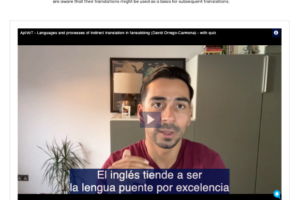Subtitling in the streaming era: Training future language professionals
Susana Valdez writes about ApiVoT, a newly launched website with educational resources for pivot audiovisual translation.
Streaming services like Netflix and Disney Plus are making more and more TV shows and movies in languages other than English. Think of, for example, the Korean drama Squid Game or the Dutch drama series Ares. Some estimates say that non-English shows will make up over 30% of all content on these services.
Pivot subtitling
To make sure that viewers around the world can watch non-English content with subtitles in their preferred language, this content is often translated through an intermediate language instead of being translated directly. Take the popular Squid Game. The series was first translated from Korean into English, and then subtitlers used the English version to translate it into Dutch. This is called pivot template subtitling. In pivot template subtitling, a stepping-stone version of the subtitles is created in a language that is different from the language of the original content and from the language of the subtitles that viewers see.
This method is highly controversial. Streaming services like it because it is fast and cost-efficient, but professional translators often see it as a threat to their profession. Pivot template subtitling is sometimes compared to the ‘telephone game’, where information is whispered from one person to another. Remember how much information gets watered down, changed or even lost when you played the telephone game as a child! Besides the translation quality, there are other ethical concerns at play, such as issues about rates and concerns about working conditions of professional translators.
Translation training: Building bridges between academia and industry
Although pivot translation is increasingly common in the industry, there are few resources on this topic that can be successfully implemented in the classroom. Those that do exist are mostly language-specific and thus only applicable to a restricted number of local contexts. This means that our students, when entering the job market, risk not having sufficient knowledge and experience of an increasingly common practice in their profession.
To make sure that graduates with degrees in translation acquire the relevant skills and knowledge, it is important to give them real-world experience and prepare them for the current realities of the market. This means building bridges between universities and the translation industry.
This can be achieved in different ways. At the end of 2020, a survey among educators in the field confirmed that they cooperate with the language industry in many different ways.1 For instance, they organize talks with professionals and market representatives, and students conduct curricular internships at translation agencies. This process can be quite time-consuming and often involves challenging logistics. For example, the pool of professionals is very much local. It is challenging to ask a subtitler from Slovakia or an expert from Portugal to come to Leiden and share their insights. Thinking back to the pandemic, when we all had to adjust our lessons at a moment’s notice, these logistical challenges and constraints of inviting and organizing talks and internships were only magnified.
We asked ourselves how we could create educational resources to be easily used in the classroom to fill the gap between education, training and industry. This was when the idea for ApiVoT was born. The ApiVoT project is the result of having identified the need for training in pivot audiovisual translation and the wish to bring the industry into the classroom.
Introducing ApiVoT
ApiVoT is an online educational tool that includes in-depth information about pivot audiovisual translation. Based on over a dozen interviews with experts2 conducted in different languages, ApiVoT includes over 40 video clips, and many embedded activities for students to participate in. The resources are open and free to use and reuse. Translators’ trainers can use them in face-to-face activities contributing to active learning, or students can use the resources for self-paced learning.


Via this platform, students are given a comprehensive overview of the main concepts; videos cover subtitling in professional and non-professional spaces, dubbing localization of video games, translation for the theatre, audio description, and project management. In the clips, experts also discuss authentic and current professional challenges and opportunities, targeting translators in training and young translators entering the job market.
The videos are not only in English, but also in Portuguese, Spanish and Catalan. They include examples from many geographic contexts, touching on issues that are relevant to many language combinations. For accessibility purposes, these videos were subtitled in the source language and also in English.
Why not try ApiVoT out for yourself and visit the website!
1 Valdez, S., Secara, A., Perez, E., & Bywood, L. (2023). Audiovisual translation and media accessibility training in the EMT network. Journal of Audiovisual Translation, 6(1), 19–44. https://doi.org/10.47476/jat.v...
2 The interviewed experts came from AVT associations from different regions (SUBTLE, ESIST, ATAV). To bridge research and practice, we also partnered with academic partners: these were translators, subtitlers, audio describers, captioners, localizers, and practisearchers.
Project team: Susana Valdez (Leiden University Centre for Linguistics), Hanna Pięta (NOVA University of Lisbon, CETAPS), Ester Torres-Simón (Universitat Autònoma de Barcelona), Rita Menezes (University of Lisbon Centre for English Studies), Lotte Ansems (Leiden University Centre for Linguistics).
Visit the ApiVoT websiteThis project was supported by an Educational Innovation Grant from Leiden University's Expert Centre for Online Learning (ECOLe), and by national funds through the Fundação para a Ciência e a Tecnologia (within the scope of the projects UIDB/00114/2020 and UIDP/00114/2020, UIDB/04097/2020 and UIDP/04097/2020, and grant 2020.08087.BD) and Ministerio de Tecnología e Innovación (project reference PID2021-122897NB-I00 by MCIN/AEI/10.13039/501100011033/FEDER).


